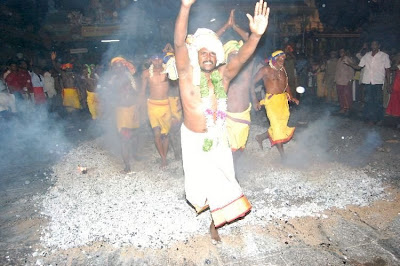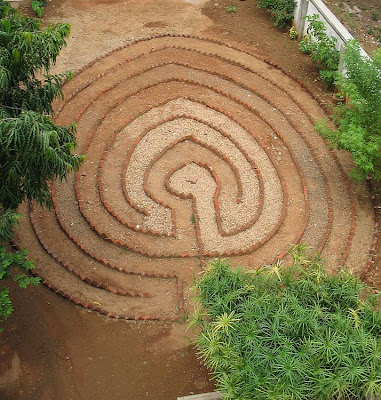Yesterday posted 'I Am Still In Shock,' about a visiting pilgrim's experience with Mottiyan Swamiji (Mooku Podi Swami). Today I received the following narrative from the same pilgrim concerning her, 'Trip to Chennai,' with Swami.
Trip to Chennai
“Anyway, I was planning to rest today after doing the girivalam yesterday in 3.45 hours, a record for me. But No, I had an inner feeling that I must visit Mottiyan Swami.
I took him some snacks and surprising got the same auto driver who took me two days ago. Mottiyan Swami was pacing the floor in the headmasters office when I arrived, and left in a huff with his two sticks. I was a little scared. was he angry with me for something?
But no, the headmaster asked me to sit down and wait for appa swami to return. Appa was back in a few minutes, he snapped the two short bamboo sticks on the floor and demanded repeatedly to be taken to Chennai.
As he was saying that a taxi owner who had more than a year ago prayed that if he could get out of the rental business and own his own taxi, then he would love for appa to ride in it. Careful what you wish for they say. He got it. Appa got in his taxi a few weeks ago and demanded to be driver around and around the Arunachala mountain in an anti clockwise and then to Chennai and some other nearby towns. Appa was in his car day and night for one full week. The only time the taxi driver got time off was to eat. Anyway, after that trip two weeks ago, today was the first day that taxi driver came to see appa for his blessings. and lo and behold, appa wanted to go to Chennai.
He asked me to come with him. I heard it once but didn’t want to go. So I pretended not to understand. All the people in the headmasters office said Appa wanted me to go to Chennai with him. To be sure for myself I repeatedly asked Appa if that was the case. At first he shyly pointed (with the two sticks) to a seat beside him. there was no way I was going to get in with him holding the two sticks. So he pointed very shyly and with a smile to the seat beside the driver. Still worried and wondering why we were going to Chennai and when we will come back, I sat in front.
It was the hottest day of the year. The sun poured in brightly thru the front window and the driver refused to turn on the AC because it would cost him more. I was baking and repeatedly wondering if I was sane to jump in the car with an almost insane (by Western standards, at least) Swami. I kept the front powder mirror down to keep an eye on Appa the whole trip
The three hour drive to Chennai was grueling but we did stop for chai that Appa graciously took from me. I offered him a snack, and he accepted that with a smile, Then he looked out the window and asked for guavas which I bought him. He asked for it to be cut. When we had them cut, he gave each of us in the car a piece. It was his prasadam to us.
That is when I found out that Appa had not bathed in 32 years. His body never smells. I Worried if I needed a tetanus shot but quickly put that thought out of my mind lest Appa found out what I was thinking. I noticed that Appa's body never sweats even though the rest of us in the car were sweating. He remained absorbed in something within himself the whole time. Off and on he would open his eyes but then close them again.
Once we reached Chennai, the driver had told us Appa would tell us where he wanted to go. But this time he didn’t The driver said Appa wanted to go to a wealthy devotee of his. My alert self wondered if it was because the taxi driver would get a baksheesh for the number of times he brought Appa to his house. So I checked with Appa myself if he wanted to go to this rich devotees house. Appa said a vehement no much to the dismay of the taxi driver.
Now the taxi driver and I had fallen out of sorts. But I didn’t care. I wasn’t going to be cheated just because I was a foreigner (and presumably loaded with money). We asked Appa if he wanted to go back to Tiruvannamalai and Appa said an enthusiastic Yes. We bought him lunch at a good restaurant that Appa ate in the back seat of the taxi. After he had eaten he threw the stainless steel tumbler out the window and the taxi driver had to jump into heavy traffic to retrieve it.
Then we were all on our way back to Tiruvannamalai. We stopped for chai that Appa accepted. Then when I got off on the way to catch an auto to the place I am staying, I bid appa good bye. He opened his eyes and with a smile nodded I could go.
I have no idea what to make of this trip. I got to be in Appa's company for six full hours. I am wondering if he was observing me to while in meditation. I hoping he was dissolving some of the bad karma I am experiencing in his meditation. I don’t know what to make of this trip. It sure was meant to be, the way I got the inner prompting to visit Appa on my day of rest after a girivalam, and then to hop into a taxi on the hottest day of the year. Will keep you informed Meenakshi Ammal of what happens. I feel blessed though to be in Tiruvannamalai and having met Mottiyan Swami.”
Trip to Chennai
“Anyway, I was planning to rest today after doing the girivalam yesterday in 3.45 hours, a record for me. But No, I had an inner feeling that I must visit Mottiyan Swami.
I took him some snacks and surprising got the same auto driver who took me two days ago. Mottiyan Swami was pacing the floor in the headmasters office when I arrived, and left in a huff with his two sticks. I was a little scared. was he angry with me for something?
But no, the headmaster asked me to sit down and wait for appa swami to return. Appa was back in a few minutes, he snapped the two short bamboo sticks on the floor and demanded repeatedly to be taken to Chennai.
As he was saying that a taxi owner who had more than a year ago prayed that if he could get out of the rental business and own his own taxi, then he would love for appa to ride in it. Careful what you wish for they say. He got it. Appa got in his taxi a few weeks ago and demanded to be driver around and around the Arunachala mountain in an anti clockwise and then to Chennai and some other nearby towns. Appa was in his car day and night for one full week. The only time the taxi driver got time off was to eat. Anyway, after that trip two weeks ago, today was the first day that taxi driver came to see appa for his blessings. and lo and behold, appa wanted to go to Chennai.
He asked me to come with him. I heard it once but didn’t want to go. So I pretended not to understand. All the people in the headmasters office said Appa wanted me to go to Chennai with him. To be sure for myself I repeatedly asked Appa if that was the case. At first he shyly pointed (with the two sticks) to a seat beside him. there was no way I was going to get in with him holding the two sticks. So he pointed very shyly and with a smile to the seat beside the driver. Still worried and wondering why we were going to Chennai and when we will come back, I sat in front.
It was the hottest day of the year. The sun poured in brightly thru the front window and the driver refused to turn on the AC because it would cost him more. I was baking and repeatedly wondering if I was sane to jump in the car with an almost insane (by Western standards, at least) Swami. I kept the front powder mirror down to keep an eye on Appa the whole trip
The three hour drive to Chennai was grueling but we did stop for chai that Appa graciously took from me. I offered him a snack, and he accepted that with a smile, Then he looked out the window and asked for guavas which I bought him. He asked for it to be cut. When we had them cut, he gave each of us in the car a piece. It was his prasadam to us.
That is when I found out that Appa had not bathed in 32 years. His body never smells. I Worried if I needed a tetanus shot but quickly put that thought out of my mind lest Appa found out what I was thinking. I noticed that Appa's body never sweats even though the rest of us in the car were sweating. He remained absorbed in something within himself the whole time. Off and on he would open his eyes but then close them again.
Once we reached Chennai, the driver had told us Appa would tell us where he wanted to go. But this time he didn’t The driver said Appa wanted to go to a wealthy devotee of his. My alert self wondered if it was because the taxi driver would get a baksheesh for the number of times he brought Appa to his house. So I checked with Appa myself if he wanted to go to this rich devotees house. Appa said a vehement no much to the dismay of the taxi driver.
Now the taxi driver and I had fallen out of sorts. But I didn’t care. I wasn’t going to be cheated just because I was a foreigner (and presumably loaded with money). We asked Appa if he wanted to go back to Tiruvannamalai and Appa said an enthusiastic Yes. We bought him lunch at a good restaurant that Appa ate in the back seat of the taxi. After he had eaten he threw the stainless steel tumbler out the window and the taxi driver had to jump into heavy traffic to retrieve it.
Then we were all on our way back to Tiruvannamalai. We stopped for chai that Appa accepted. Then when I got off on the way to catch an auto to the place I am staying, I bid appa good bye. He opened his eyes and with a smile nodded I could go.
I have no idea what to make of this trip. I got to be in Appa's company for six full hours. I am wondering if he was observing me to while in meditation. I hoping he was dissolving some of the bad karma I am experiencing in his meditation. I don’t know what to make of this trip. It sure was meant to be, the way I got the inner prompting to visit Appa on my day of rest after a girivalam, and then to hop into a taxi on the hottest day of the year. Will keep you informed Meenakshi Ammal of what happens. I feel blessed though to be in Tiruvannamalai and having met Mottiyan Swami.”




















































